Disclosure: Please note that some links are affiliate links, and at no additional cost to you, we earn a commission if you make a purchase.
If you would like to support this website in some way, using these links will help do exactly that.
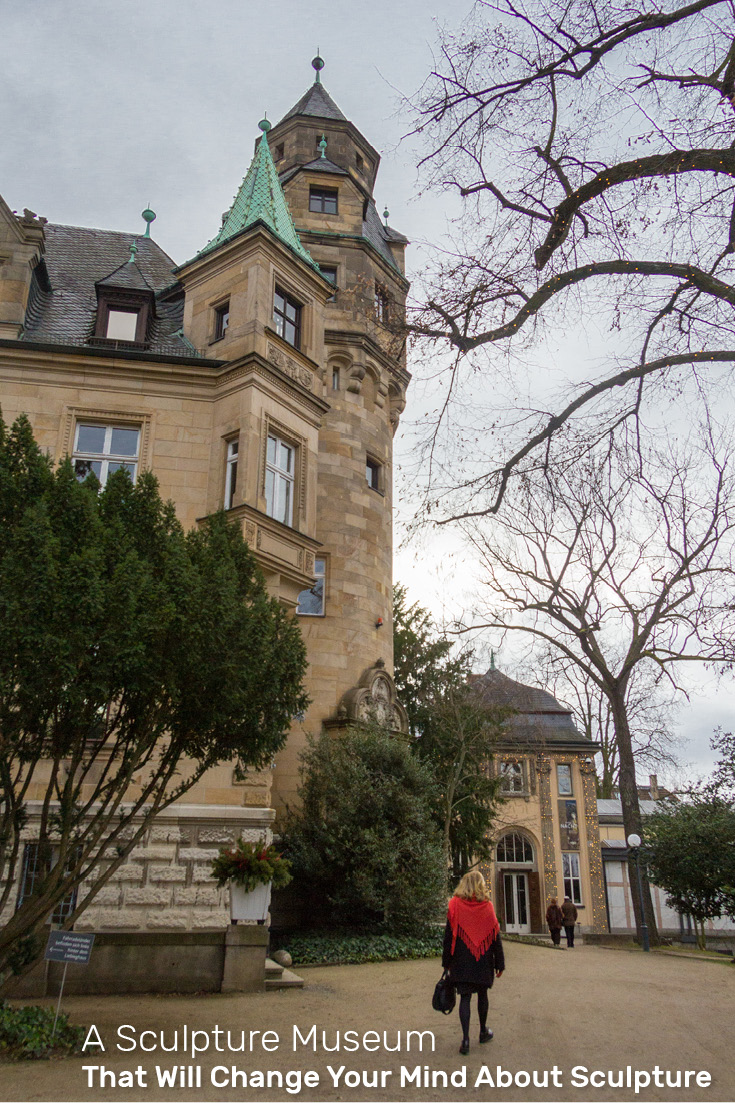
When visiting the Liebieghaus Skulpturensammlung, you feel as if you’re visiting a noble German uncle that you’ve heard so much about. Along the river Main in Frankfurt, Germany, the museums are lined up neatly in a row. Most were obviously homes at one time. Through an iron gate, you walk along what was once a driveway towards a ‘villa’, what to me seems like a mansion, but ok. In such a big city as Frankfurt, there is a surprising expanse of green grass and landscaping in front. There are outdoor sculptures nestled amongst the trees and shady areas of the yard, distracting the visitor from the front door.
Gründerzeit Architecture
The museum building is a work of art as well. The villa was designed by Munich architect Leonhard Romeis between 1892 and 1896 for the textile manufacturer Heinrich Baron von Liebieg (where Liebieghaus gets its name). The architecture style is called Gründerzeit, which translates to Founder’s Period. During that time, urban housing in Austria and Germany was booming, and entire streets of town homes were being built four to six stories high. Historic periods such as Classical, Gothic, Renaissance, and Baroque were all being emulated and blended together as part of the larger Historicism movement of the era. In the Liebieghaus in particular, the architect Romeis blended South Tyrolean and the Bamberg Renaissance, and various other styles. What better stage to curate a sculpture museum that covers 5,000 years of history, from Ancient Egypt to Neoclassical than in a villa that was lovingly designed to honor those periods. It's a happy synergy.
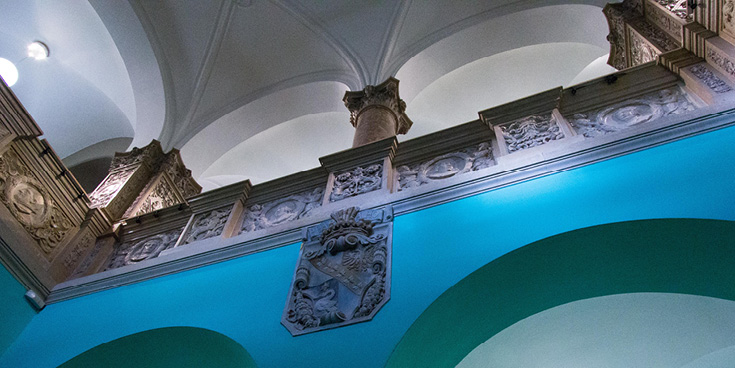
Don’t Repeat My Mistake
I tend to overlook sculptures when I’m in an art museum, so I dismissed visiting the Liebieghaus, an art museum dedicated solely to sculpture, in Frankfurt am Main for years. Over time though, repeatedly the Liebieghaus would come to my attention, either in rave reviews of guide books or from Frankfurt natives. All reports declared that it was exemplary and not to be missed. Eventually, my curiosity got the better of me. I was admittedly starting to feel guilty after I’ve visited neighboring Staedel Museum five-six times in the interim! You can read How the Staedel Museum Stole My Heart here if you're curious.
Now, I’m going to be another voice singing the praises of this museum.
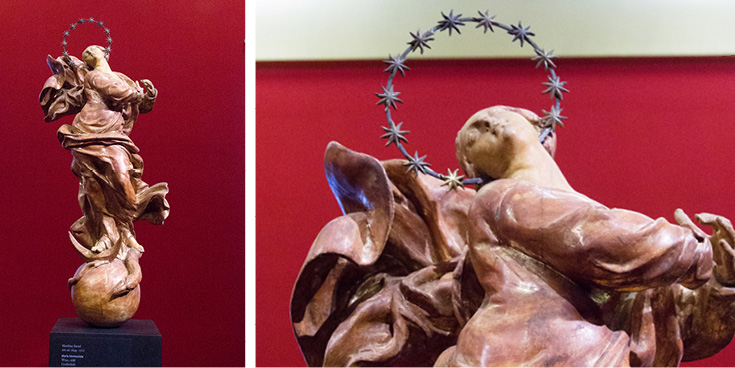
Why? Maybe it's because with only sculptures on display it's easier to absorb them without being distracted by paintings on the wall. Perhaps the dramatic wall colors and high contrast lighting really brings the sculptures to life? In an art museum with both paintings and sculptures it's hard to light both mediums dynamically.
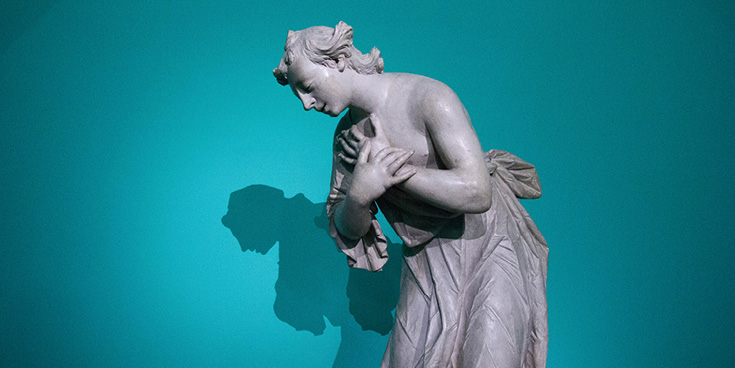
Regardless, I wasn’t bored, and neither was Sebastian. The museum is the right size, cozy yet grandiose, and you can see a majority of the collection in one visit. The signage is predominately bilingual, German and English, which helps so much. If there’s a special exhibition currently running, be sure to check out the exhibit’s Digitorial online to learn more about what you’ll see. For example, this is what is currently running, Between Definite and Dubious.
Gods in Color
The Liebieghaus collection is the proud parent to a traveling exhibit that has been touring museums all over the world for fifteen years. It dispels the commonly-held belief that classical sculpture from Ancient Greece and Rome have always been white marble. Science and extremely lucky archaeological discoveries have been able to prove otherwise, and the Liebieghaus has gone to such lengths as to present actual-size reproductions in the ‘original color format’ next to the surviving, authentic pieces as part of the museum's permanent collection.. Wow are they bright! It's shocking to see! Here’s the museum’s Digitorial about the exhibit Gods in Color.
Neoclassical Ariadne on the Panther
I’m a cat person. Undeniably my jaw dropped when I saw Ariadne on the Panther. Arguably the most famous and celebrated sculpture in Frankfurt is the Neoclassicist Johann Heinrich Dannecker’s Ariadne on the Panther, a visual play of beauty and mankind conquering wild nature. The Liebieghaus shared the history and restoration of this beloved piece on their blog, The Ariadne File.
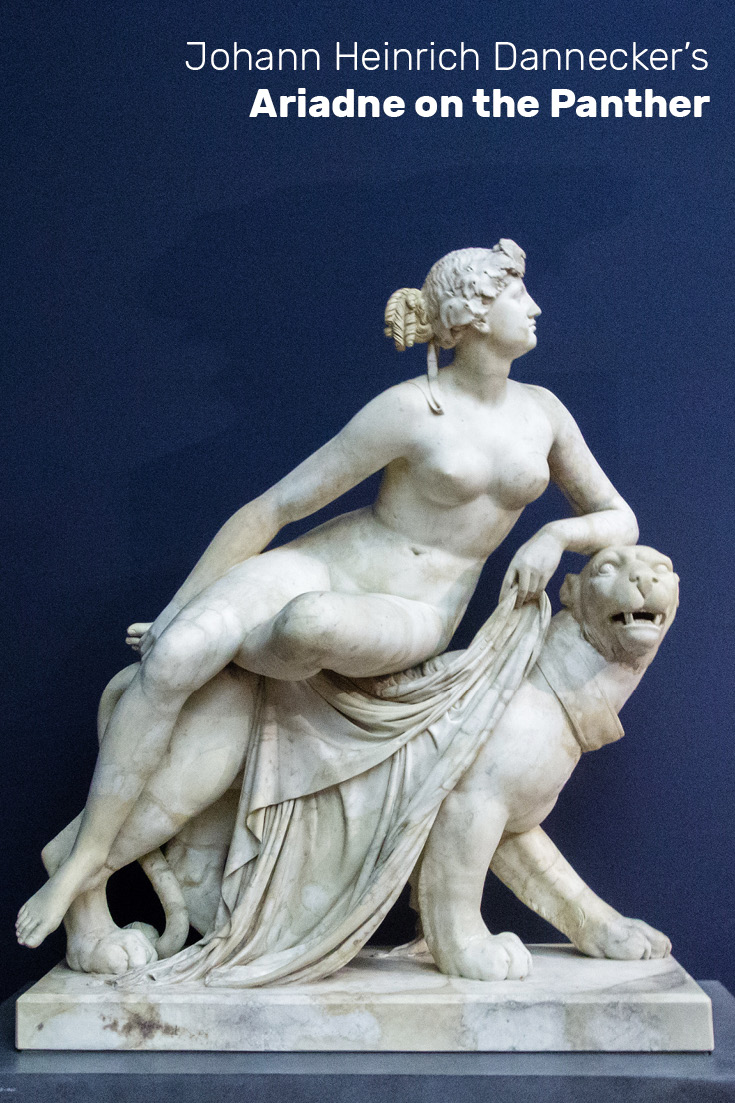
Ancient Egypt
I was most excited to see the collection from ancient Egypt, and it lived up to my anticipation. I loved how the museum positioned the mummy lids so that you can see inside the lids as well as the exterior.
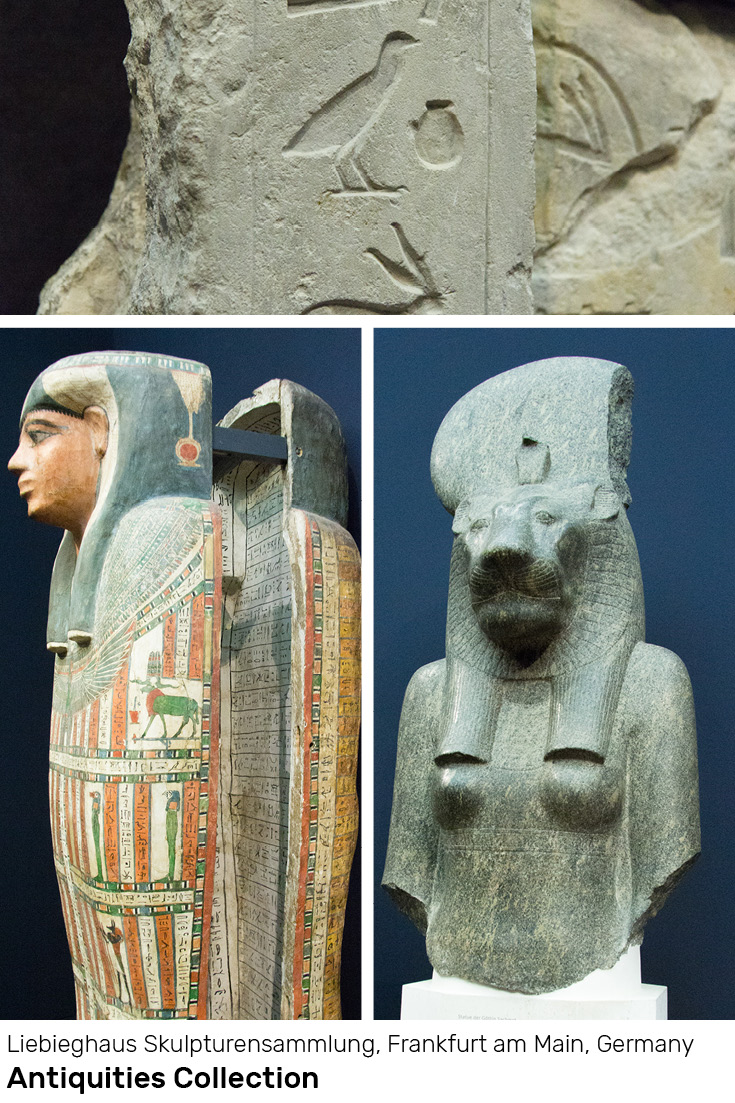
I didn’t expect to see paintings on wood panels from that time period. It's a marvel that such fragile materials survive for so long! During Greek and Roman rule in Egypt, mummy burial customs adapted the ancient Greek painting style into an additional element, a painted portrait on wood panel of the deceased enclosed with the body.
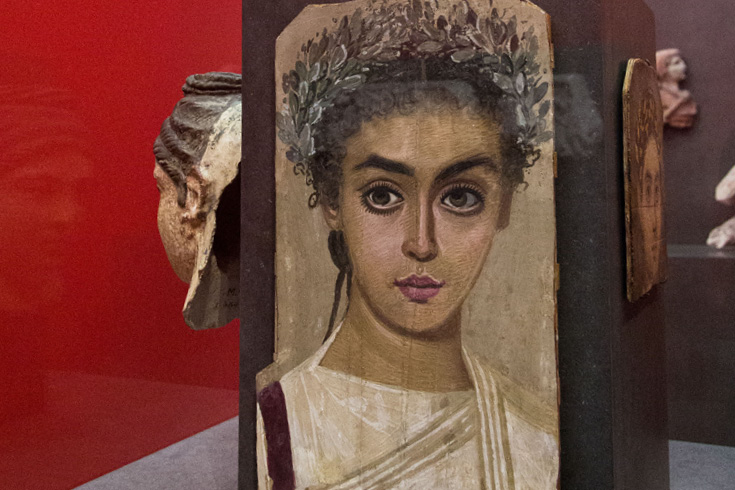
One More Thing
You have to see the conservation and restoration workshop video posted by the museum, it's incredible, and has English subtitles!
Have You Been To the Liebieghaus? Have you ever put off a museum only to regret not seeing it sooner when the time came? Let us know in the comments.
Follow Along
If you enjoyed this article, or these topics sound interesting to you, you'll love our weekly newsletter. You'll receive the newest posts each week and exclusive access to free planning resources like ‘Packing List & Tips for 2 Weeks in Germany’ and ‘Everything You Need to Rent a Car in Germany’.
Thank you for reading!

There are different methods of transportation that we have used in Germany over the years. We have boarded airplanes, rented cars and traveled by train. My favorite way to get around? That would be train travel and here are four reasons why I tend to choose spending hours on a train instead of another mode of transportation.
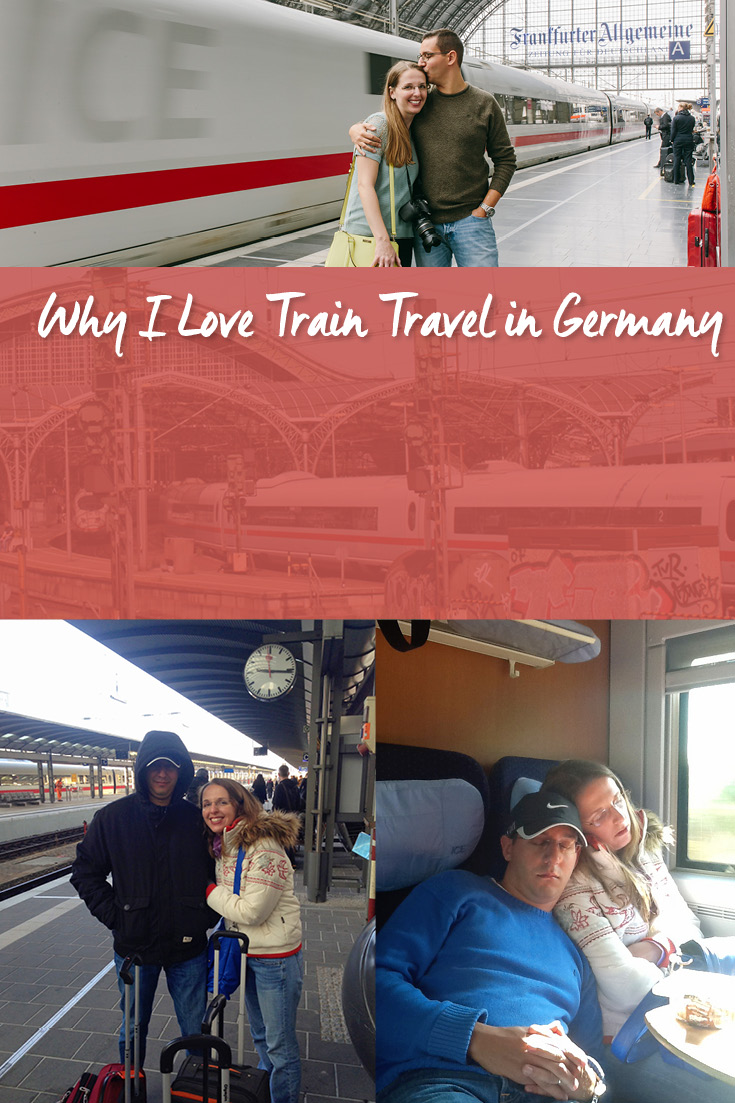
Reason #1 See More of the German Countryside
All trains have large windows where you can enjoy the landscape as it flies by (especially in the ICE high speed trains). You will see rivers, mountains, and small villages - all of which you miss when you fly or take the car on the Autobahn. Of course you can take rural roads with a rental car, but it will be slower and the driver will have to watch traffic much more than any landscape surrounding the car.
Board the train, find your seat, get comfortable and enjoy whatever you like to do. If looking out the window is not your thing, you can read, listen to music, or sleep a bit. Lots of high-speed trains have free Wifi (https://www.bahn.com/en/view/trains/on-board-service/wifi.shtml) and outlets to charge your devices and stay in contact with your family and friends back home. Just don’t get too distracted and miss your destination while enjoying the comfort of the train.
Reason #2 No Luggage Restrictions
Bringing any kind of luggage onto an airplane these days, usually results in a fee you have to pay. This means extra income for the airlines and customers are willing to pay anywhere from $20 to $75 for this convenience. Not so on the train (or your rental car, of course). Bring as many pieces of luggage as you want, or are able to pull along with you. Even pack liquids and something to drink inside the train. No one will take it away from you.
Denise and I usually share a larger suitcase instead of two smaller ones. Most long distance trains have an extra area between seats where you can store your luggage. Otherwise you can lift it onto the rack above the seats, just make sure it is not too heavy and falls on your head.
Reason #3 Less Expensive
When comparing plane tickets or car rental prices to a train ticket, the train ticket is often your least expensive option, especially when you buy your ticket in advance and factor in the hidden costs. The airline might charge you extra for your luggage, even if it is just a carry on bag. And you better buy a preferred seating position with that, so you board the plane while overhead space for your carry-on is still available.
The same goes for the rental car option, which will have you paying for fuel costs and parking, not to mention all the extra insurance fees they try to add when you pick up your car. If you want to know more about this, read our earlier article, What to Consider When Renting a Car in Germany.
The best way to get your hands on an inexpensive train ticket in Germany (usually half-off) is to book 70-90 days before your trip on the website of the Deutsche Bahn.
You can get tickets for as low as 29 € per person for long trips, but ticket prices go up as the departure date draws near, so plan accordingly, and buy early. Denise and I will create a calendar event exactly 90 days before in order to get the best train ticket price. When its time to buy, simply enter your destination, date and approximate time on the Deutsche Bahn website and you will be given a range of options to choose from. When reserving your train ticket, you pick your favorite connection and have the option to purchase reserved seating for about 5 € per person/train. There are no other fees added on after you check out. I highly recommend purchasing a seat, especially if you are on the train for several hours or travel with a larger group of people.
You will also see that some connections will be faster, some slower. Here is a ranking from fastest to slowest trains:
• ICE (Inter City Express) usually pronounced ‘Eye See Eee’, are the fastest German trains
• IC (Inter City) trains are a bit slower than ICE trains with a few more stops along the way
• RB (Regional Bahn) and RE (Regional Express) tend to be highly localized with lots of stops. You will see more of the countryside, on IC/RB/RE trains, but travel time can be up to double compared to an ICE train.
Reason #4 Simply, Faster
In Germany you might overhear someone saying, that the train is “late, again”. Some trains are notorious for running late and Germans, always punctual, are notorious for complaining about this fact. However, I still believe taking a train is the fastest option, and here is why. A train ride from Frankfurt to Paris, France will take about 4 hours. A car ride will take 5 ½ hours, if there is “normal” traffic on the Autobahn 4 from Frankfurt to Paris. It takes longer due to the lower speed limit in France, which is 130 km/h (80 mph). A train can go as fast as the tracks will let it and reaches speeds up to 200 mph on some track parts.
So driving can’t compete with taking the train, which leaves us with flying. A plane ride from Frankfurt to Paris takes only 1 hour 10 minutes. However, if you add transportation time to the airport (most are not in the city center, unlike train stations) and being there about 2 hours before your flight takes off for security checkpoints and boarding, the journey will most likely take longer than 4 hours. Keep in mind that the security check at the airport might slow you down, also. Oh yeah, and you have to pay for your bags and deal with less legroom on a plane.
What is your favorite mode of transportation while visiting Germany? Let us know in the comments.
Bonus Germany Train Travel Resource: If you're new to train travel, do yourself a BIG favor and read Lorelei's Your Complete Guide to Using the Deutsche Bahn in Germany. Its a wonderful resource for newbies, full of photos and explanations. We thought of doing one ourselves, and stumbled upon Lorelei's and realized she left NOTHING out. Bookmark it, and you'll thank yourself later.
Follow Along
If you enjoyed this article, or these topics sound interesting to you, you'll love our weekly newsletter. You'll receive the newest posts each week and exclusive access to free planning resources like ‘Packing List & Tips for 2 Weeks in Germany’ and ‘Everything You Need to Rent a Car in Germany’.
Thank you for reading!

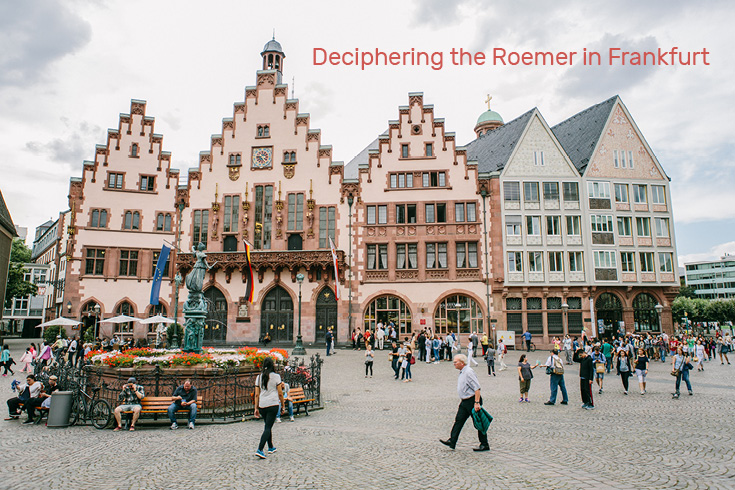
Before the stadium-sized exhibition halls Frankfurt am Main, Germany has today, there was the Römer, or Roemer for the umlaut-allergic. Roemer refers specifically to the City Hall complex that grew from a labyrinth of fancy merchant homes that were bought in 1405 by the city and retro-fitted for the city council’s needs. It was here that the first trade fairs were held, in the myriad of halls, nearby square, and neighboring streets, until the trade fairs couldn’t fit anymore. The Roemer resides in the center of the city on the Roemerberg, a square made out of Fachwerkhäusern, half-timbered houses.
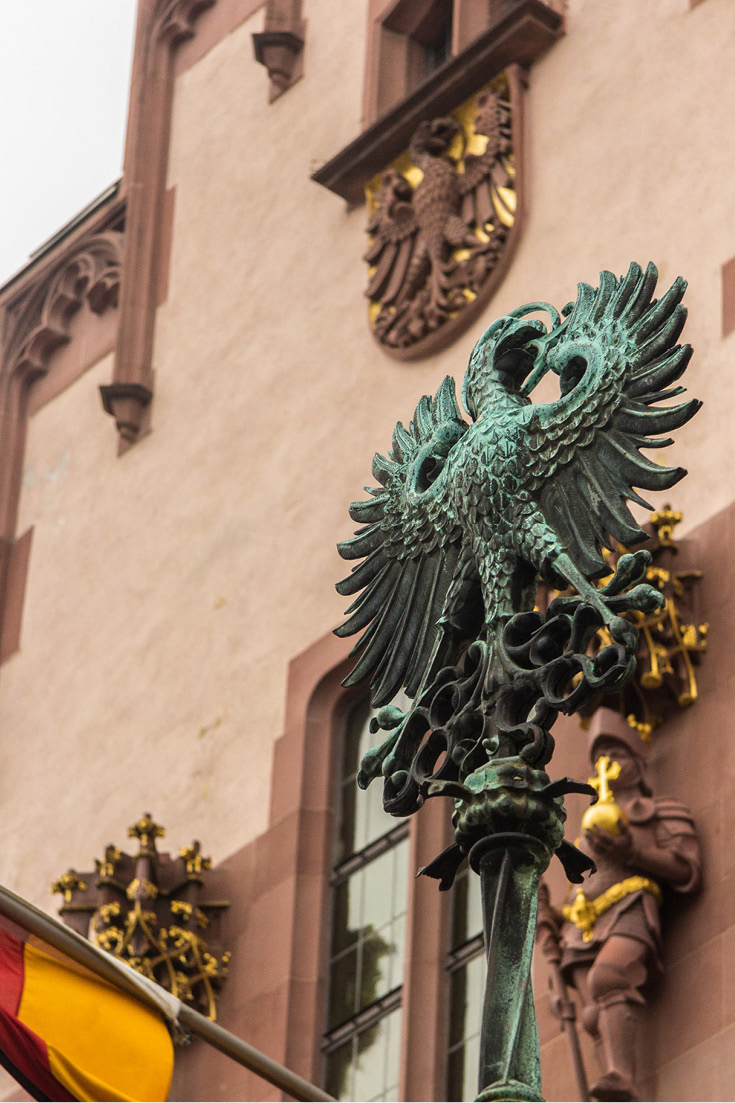
Why the Roemer? Like most good nicknames, no one is sure why the Roemer is called the Roemer. Some allege Italian visitors for the trade fairs stayed there and thus named it the German word for Romans, Roemer, or perhaps because of the building's ties to the Holy Roman Empire and its election of Kings. After a King was elected, the coronation dinner was held in the Roemer in the Kaisersaal, or Emperor Hall. The Roemer hosted the Kings of the Holy Roman Empire from 1562 to 1792.
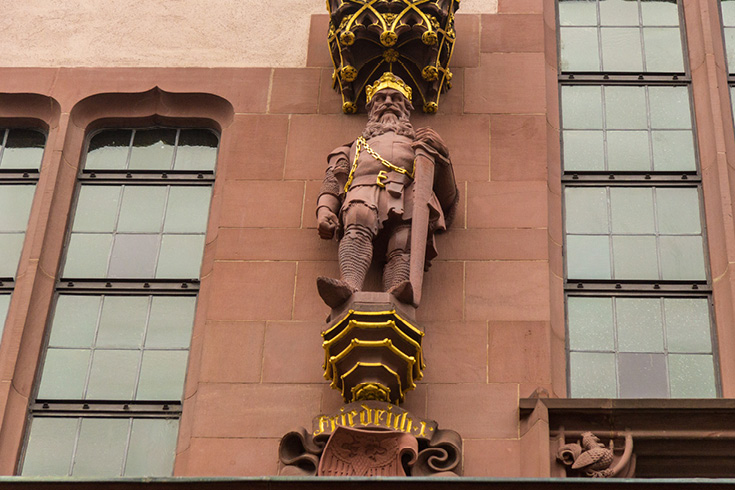
Comparing Germany’s Town Halls
Frankfurt am Main’s city hall complex is unlike any I have seen in Germany, and certainly completely different from earlier posts about the Rathaus in Bremen and the Neues Rathaus in Munich. That being said, it is built in the same architecture style as the Neues Rathaus in Munich, Gothic Revival. Both the Roemer and the Neues Rathaus in Munich were built or remodeled at a time when Germany was seeking to revisit the glory days of the time period belonging to Bremen’s Rathaus. If you missed those posts, and you like this one, I encourage you to check them out: Architecture Style Guide to the Neues Rathaus in Munich, and The Epic German City Hall All the Other City Halls Wish To Be.
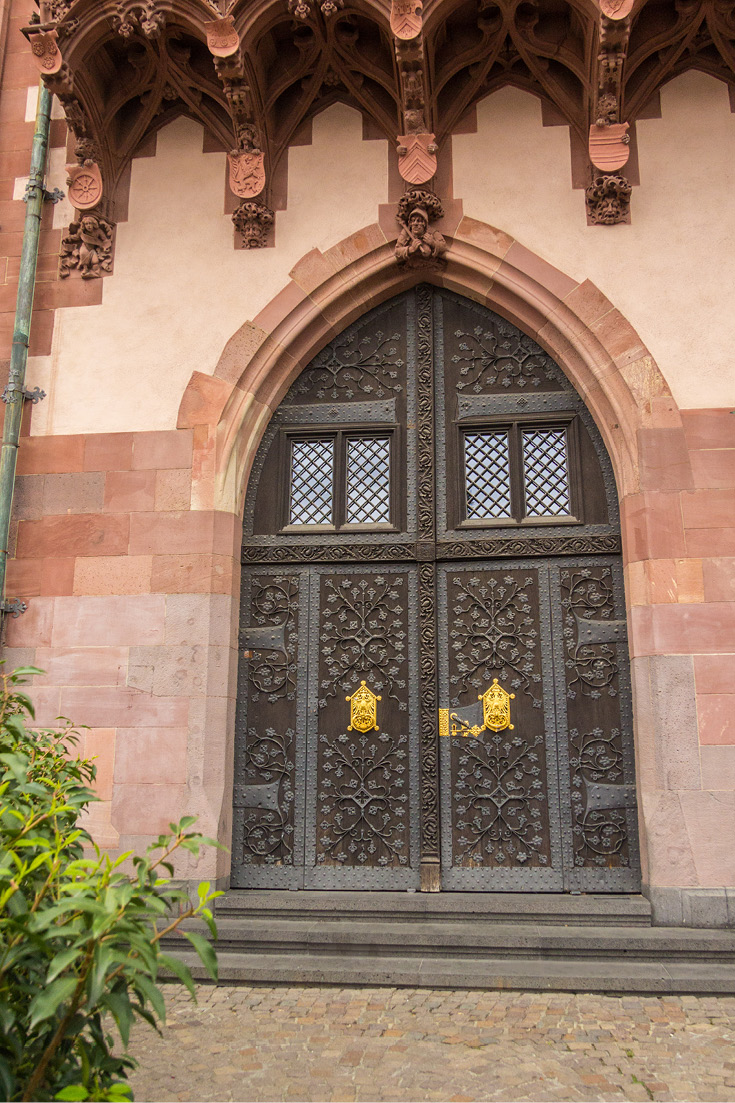
Symbolism on the Roemer
Typical for Gothic Revival, you’ll see pointed arches, decorative patterns, and embellished structural elements. Without a tour guide, the symbolism on the Roemer’s facade is missed by many visitors.
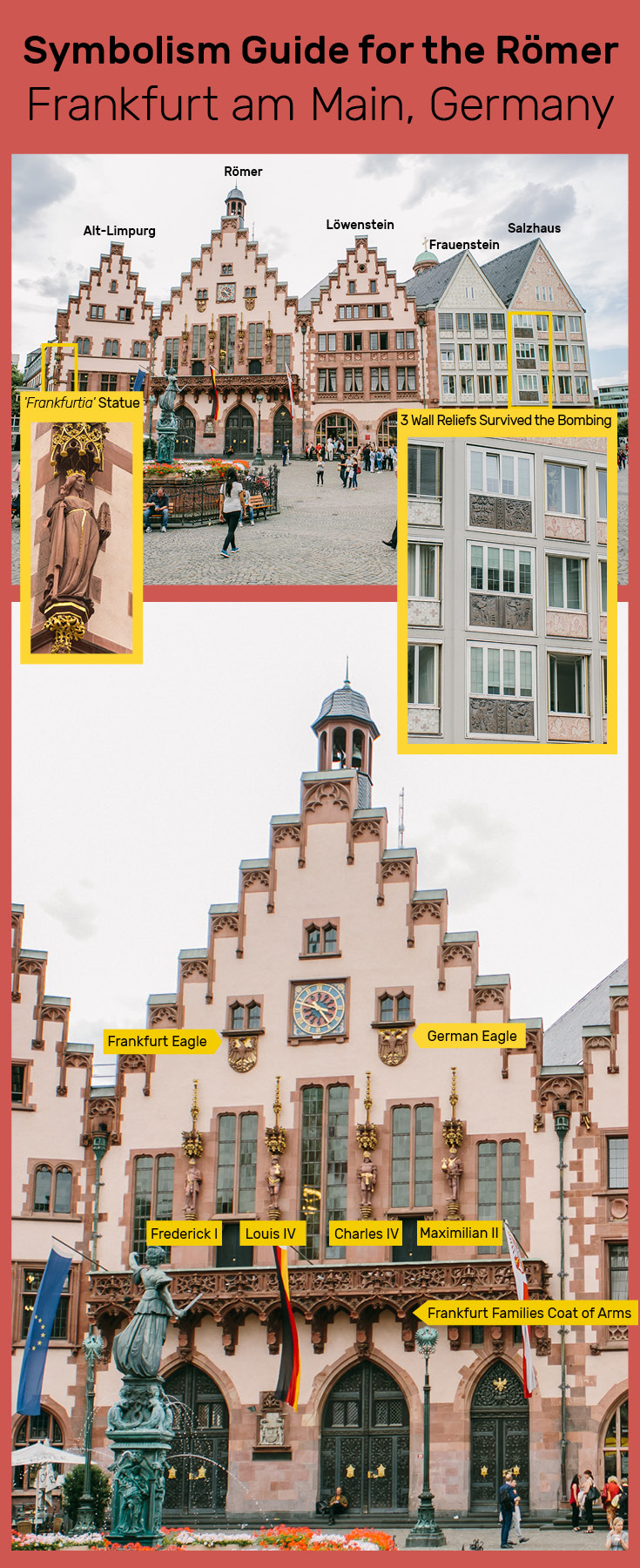
Top to Bottom, the Frankfurt am Main Roemer Iconography, Highlights and Descriptions
• Lantern cupola on top has not been refurbished after the bombings of World War II, it is as it was originally built in the 1700s.
• Clock built by Frankfurt clock-maker Hans Hochgesang in 1452-1454. The time can be read from inside the Kaisersaal as well.
• Two Eagle Sculpture reliefs, the single Eagle on the left is for Frankfurt, the double-headed Eagle on the right is for Germany.
• Four Holy Roman Emperors, all who had a significant impact on the city of Frankfurt am Main. From left to right, Frederick I, the first king elected in Frankfurt in 1152, Ludwig the Bavarian who extended the city’s trade rights in 1331, Charles IV for decreeing the Golden Bull of 1356, and Maximilian II, the first ruler crowned in the Frankfurt Cathedral in 1562.
• Below the balcony are coat of arms of various families of Frankfurt.
• Wall relief commemorates the 1900 remodel, “House of the Romans, bought and rebuilt by the city of Frankfurt am Main in 1405, and the town hall of the Reichstag and Imperial elections 1886 to 1900 by Max Meckel, newly manufactured.”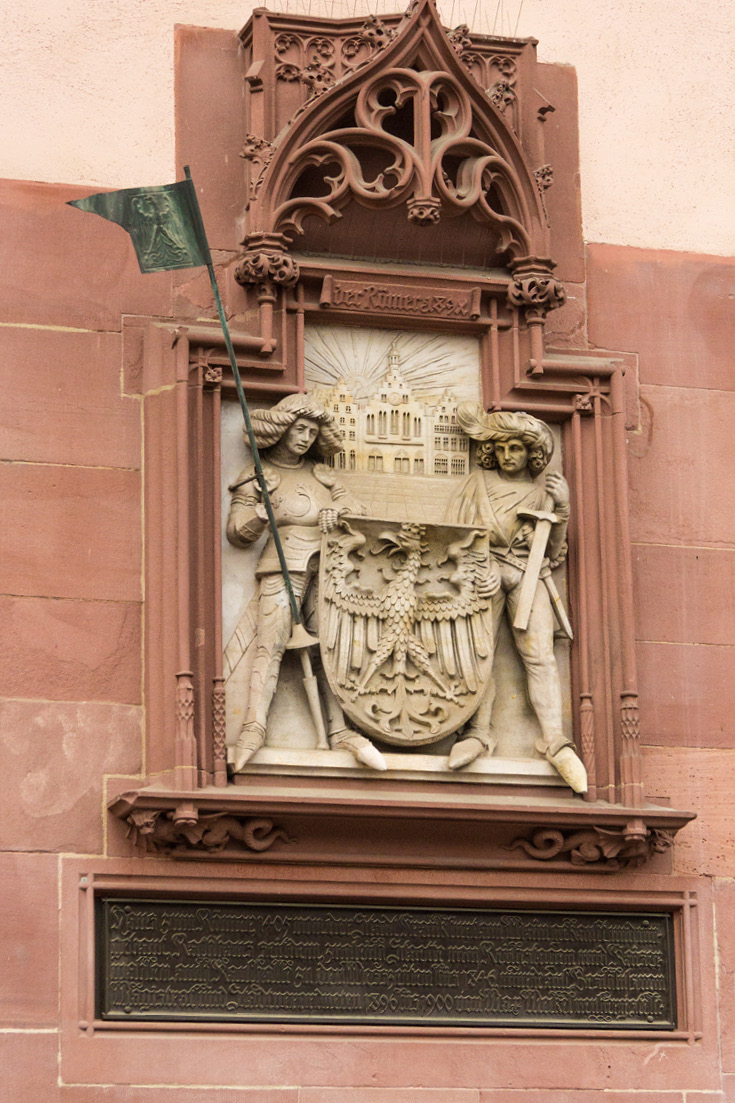
On the neighboring building front to the left of the Roemer, the Alt-Limpurg house, be sure to see the ‘Frankfurtia’, Statue, or as Germans know her, Francofurtia, the female embodiment, protector of the city of Frankfurt. She's holding the sword of Charlemagne in her right hand and the Pfarrturm, church tower in her left.
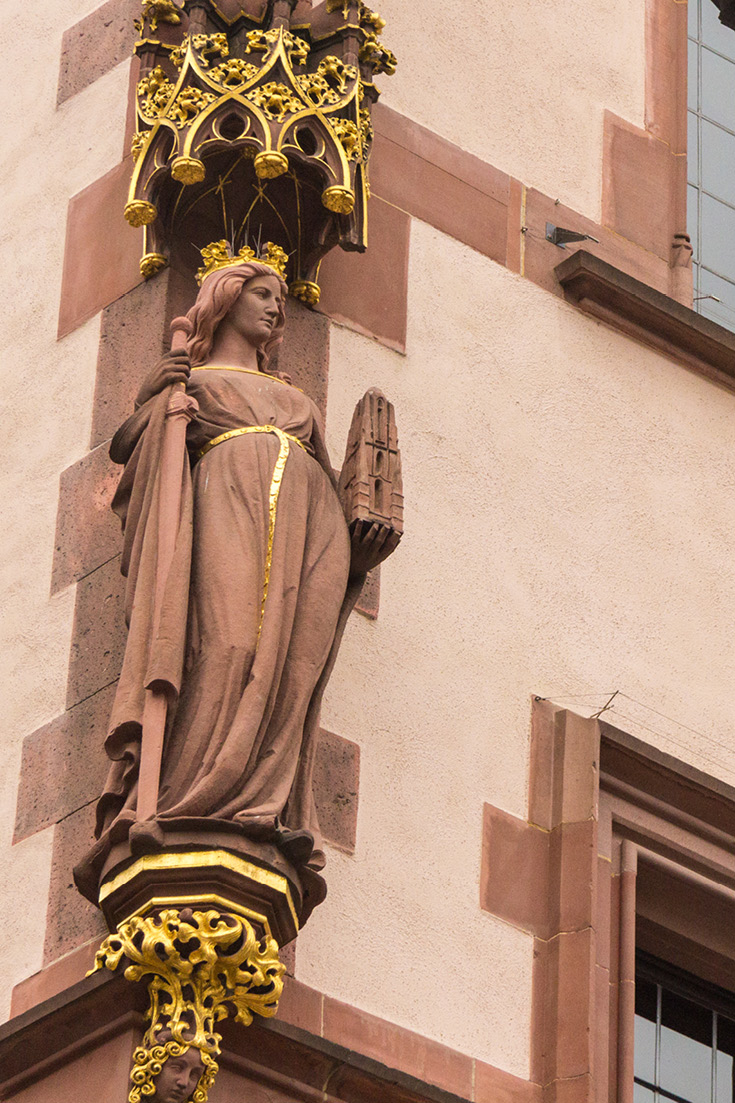
Finally, on the far right side of the Roemer facade, the Frauenstein and Salzhaus, look for the three surviving wall reliefs that were salvaged from the World War II bombings. They serve as a reminder for all of what was lost. Currently, there is a Frankfurt Tourist Information Office located in this part of the Roemer.
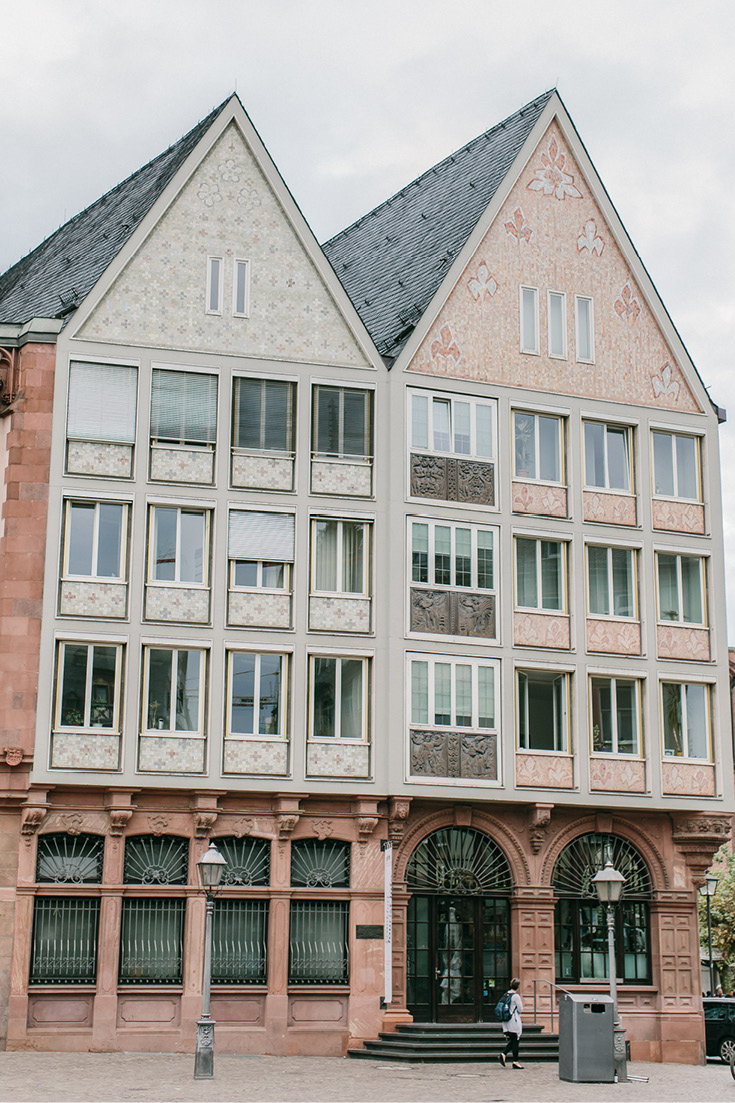
Follow Along
If you enjoyed this article, or these topics sound interesting to you, you'll love our weekly newsletter. You'll receive the newest posts each week and exclusive access to free planning resources like ‘Packing List & Tips for 2 Weeks in Germany’ and ‘Everything You Need to Rent a Car in Germany’.
Thank you for reading!

